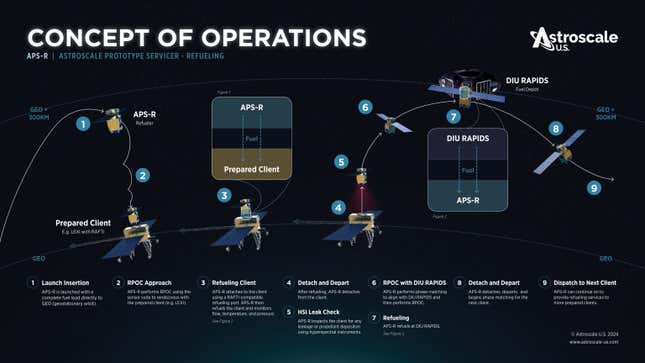Zipping far above Earth, it’s not exactly easy for satellites to find a corner gas station when the fuel gauge gets low. To tackle this cosmic conundrum, a Space Force-funded initiative is working on an innovative solution to refuel distant satellites on-the-fly.
On Wednesday, Space Force awarded Astroscale a $25.5 million contract to design and construct an orbital transfer vehicle, also known as a space tug. The vehicle, dubbed the Astroscale Prototype Servicer for Refueling (APS-R), needs to be ready for launch by 2026. Operating in geostationary Earth orbit (GEO), this maneuverable satellite will specialize in refueling other compatible satellites, thereby enhancing the longevity and functionality of these orbital assets.
Hundreds of military, government, and commercial satellites currently orbit in GEO, about 22,000 miles (36,000 kilometers) above Earth (that’s about one-tenth of the distance to the Moon). This position is ideal for communication, weather, and national security satellites, but, at this distance, it’s difficult, if not impossible, for operators to check, fix, or update them. This is where APS-R could help, providing a means for extending the working lifespan of these distant, and often expensive, satellites.
Ron Lopez, president and managing director of Astroscale U.S., likened the advent of orbital refueling stations to the introduction of in-air refueling capabilities, such such an ability would enhance the range and mobility of satellites. “APS-R opens the door to rethinking the way satellites are designed and operated, marking a significant leap forward in the capabilities and sustainability of satellites in orbit,” Lopez explained in Astroscale’s press release.

If successful, APS-R has the potential to revolutionize and simplify the in-space refueling process. It will carry and deliver fuel, specifically hydrazine, directly to other spacecraft, allowing them to continue their missions without interruption. Designed to be about the size of a gas pump, APS-R will be able to perform multiple refueling tasks in GEO. In addition to Space Force contributing $25.5 million to the project, Astroscale, and its partners will throw in an additional $12 million. For its construction, Astroscale U.S. has chosen the Southwest Research Institute in San Antonio, Texas, to build the APS-R’s main body, known as the bus.
The Space Systems Command of the U.S. Space Force, responsible for managing a $15 billion acquisition budget, was responsible for issuing this prototype design request, and it did so through the Space Enterprise Consortium, which aims to fast-track the development of in-space capabilities, such as refueling, transportation, servicing, and debris mitigation, to enhance space operations and counter emerging threats.
“With APS-R, we are not merely extending the operational life of satellites; we are enhancing our responsiveness, flexibility and overall mission capabilities,” said Space Force colonel Joyce Bulson. “This collaboration signifies a bold step forward in our efforts to secure and strengthen the U.S. Space Force’s position in an ever-evolving space domain, reinforcing our commitment to innovation and ensuring the sustainability of our space assets.”
APS-R isn’t the only venture of its kind, as there are several initiatives and concepts for similar orbital transfer vehicles. Northrop Grumman’s Mission Extension Vehicle (MEV), with two having already launched to space, extends satellite life by taking over propulsion and control functions. DARPA’s Robotic Servicing of Geosynchronous Satellites (RSGS) program aims to develop a robotic servicing vehicle for satellite repair and relocation. But none of these can or will do what APS-R proposes to do: directly refuel satellites in space. That said, SpaceX is developing an innovative in-space refueling solution in which Starship upper stages serve as orbital tankers to refuel other Starships in orbit, extending their range and enabling ambitious deep-space missions.
The APS-R project is a good example of what the Space Force was actually set up to do. It’s not sci-fi or space battles, but more about making sure the U.S. has the assets it needs to maintain a functional, flexible, and secure space environment. The concept of an orbital gas station fits this mission quite nicely.
For more spaceflight in your life, follow us on X (formerly Twitter) and bookmark Gizmodo’s dedicated Spaceflight page.

